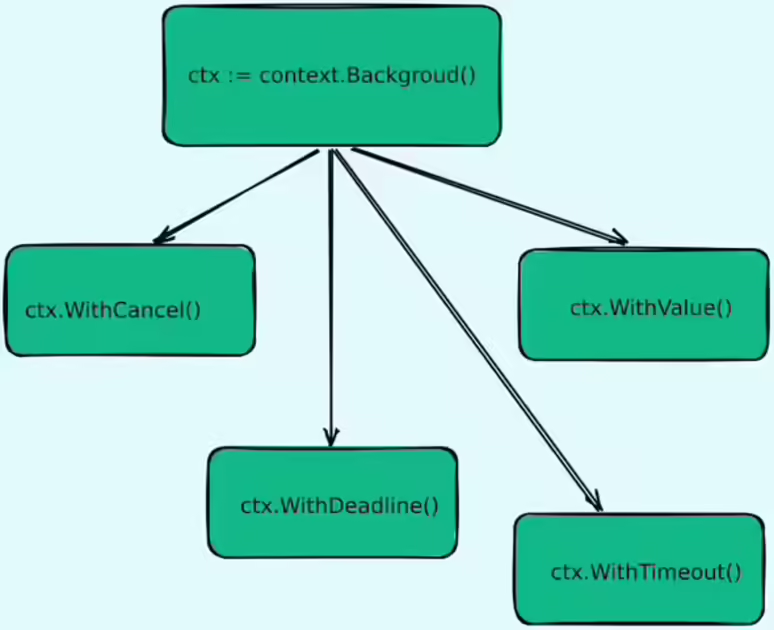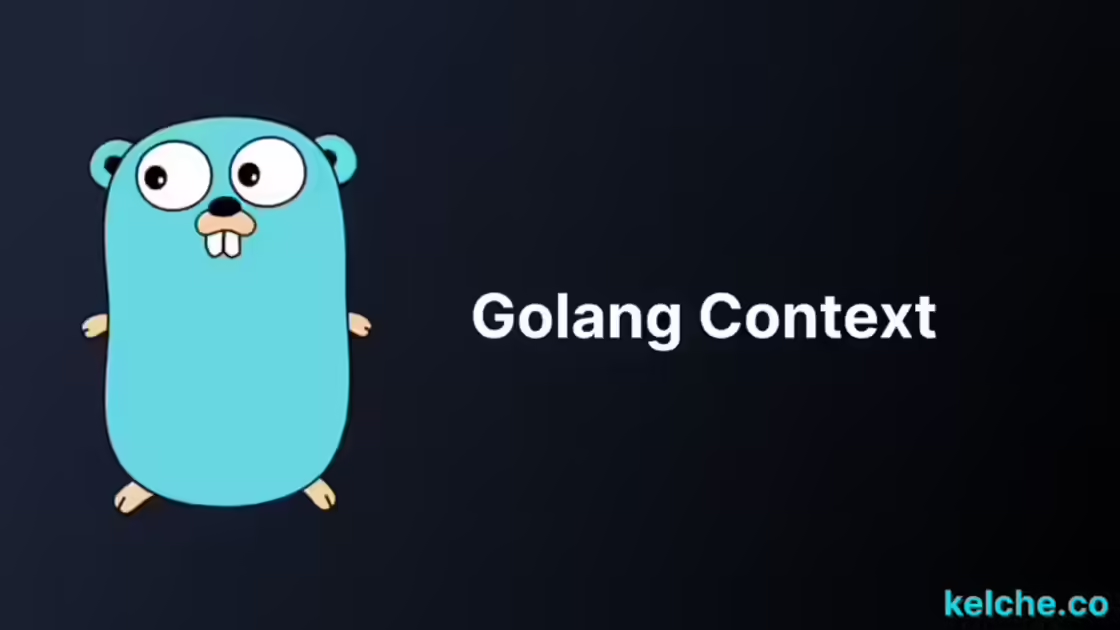Golang Context (A Complete Guide)
Introduction
In Go, contexts are used to pass request-scoped values, deadlines, and cancellation signals between processes and API boundaries. Since contexts are immutable, it is safe to pass them around even between different goroutines.
Context is implemented in the standard library and you can find the docs here.
In this article, we are going to explore how to use context in real-world applications.
Creating Contexts
Contexts can be created in two ways:
- Using the
context.Backgroundfunction - Using the
context.TODOfunction
The context.Background function is used to create a context with no parent and is the root context. This context is used to create other contexts. The context.TODO function is used to create a context with no parent and is used when the parent context is not yet available.

package main
import (
"context"
"fmt"
)
func main() {
ctx := context.Background()
fmt.Println(ctx)
ctx = context.TODO()
fmt.Println(ctx)
}Passing Values with Context
One of the applications of context is to pass values between processes. This is done by using the context.WithValue function. This function takes a context and a key-value pair and returns a new context with the key-value pair added to it.
To access the values in the context, we can use the context.Value function. This function takes a context and a key and returns the value associated with the key.
Note: Passing values should only be done when necessary otherwise use arguments to pass values. Values in the context should be request-scoped and not application-scoped.
To avoid collisions, it is recommended to use a custom type as the key.
package main
import (
"context"
"fmt"
)
type User struct {
Name string
Age int
}
type key string
func someFunc(ctx context.Context) context.Context{
return context.WithValue(ctx, key("user"), User{
Name: "John Doe",
Age: 20,
})
}
func main() {
ctx := context.Background()
ctx = someFunc(ctx)
user := ctx.Value(key("user")).(User)
fmt.Println(user)
}{
John Doe 20
}In the above program, we are passing a as a value in the context. We can also give primitive types like string, int, bool, etc. as values in the context. In the main function, we are accessing the value using the context.Value function and type asserting it to the User struct.
Cancellation with Context
Cancellation is important in cases where we want to stop a process if it takes too long. For example, if we are requesting an API endpoint and the request takes too long, we can cancel the request and return an error. This will prevent the request from hanging indefinitely and misusing resources.
Contexts can also be used to cancel a process. This is done by using the context.WithCancel function. This function takes a context and returns a new context and cancel function. The cancel function is then used to cancel the context.
package main
import (
"context"
"fmt"
"time"
)
func someFunc(ctx context.Context) {
select {
case <-ctx.Done():
fmt.Println("Context cancelled")
case <-time.After(5 * time.Second):
fmt.Println("Context not cancelled")
}
}
func main() {
ctx := context.Background()
ctx, cancel := context.WithCancel(ctx)
go someFunc(ctx)
time.Sleep(2 * time.Second)
cancel()
time.Sleep(2 * time.Second)
}A lot is going on in the above program. Let’s break it down.
In the someFunc function, we are using the select statement to check if the context has been canceled. If the context has been canceled, we print Context canceled. If the context has not been canceled, we print Context not canceled.
The ctx.Done function returns a channel that is closed when the context is canceled. This is a method implemented on the context.Context interface. The time.After function returns a channel that sends the current time after the duration has elapsed. This is used to simulate a process that takes a long time.
In the main function, we are creating a context using the context.Background function. We are then creating a new context using the context.WithCancel function. This function takes a root context and returns a new context and a cancel function. The cancel function is used to cancel the context. We are then passing the new context to the someFunc function.
The main function then sleeps for 2 seconds and then calls the cancel function. This cancels the context and the ctx.Done channel is closed. This causes the select statement in the someFunc function to print Context canceled.
The main function again sleeps for 2 seconds and then exits. This is to show that the time.After channel does not send the current time after 5 seconds. This is because the context was canceled after 2 seconds.
The above program prints the following output:
Context not canceled
Context canceledTimeout with Context
Timeout is another important application of context. This is used to cancel a process if it takes too long. This is done by using the context.WithTimeout function. This function takes a context and a duration and returns a new context and cancel function. The cancel function is then used to cancel the context.
package main
import (
"context"
"fmt"
"time"
)
func someFunc(ctx context.Context) {
select{
case <- ctx.Done():
fmt.Println("Timed out")
case <- time.After(5 * time.Second):
fmt.Println("Not timed out")
}
}
func main() {
ctx := context.Background()
ctx, cancel := context.WithTimeout(ctx, 2 * time.Second)
go someFunc(ctx)
time.Sleep(3 * time.Second)
cancel()
time.Sleep(2 * time.Second)
}The difference between context.WithCancel and context.WithTimeout is that the context.WithTimeout function takes a duration as an argument. This is the duration after which the context is canceled. The context.WithCancel function does not take a duration as an argument. This is because the cancel function can be called at any time to cancel the context.
The above program prints the following output:
Timed outDeadline with Context
Deadlines are similar to timeouts. The difference is that deadlines are absolute times. This is done by using the context.WithDeadline function. This function takes a context and a time and returns a new context and cancel function. The cancel function is then used to cancel the context.
Absolute time is the time since the Unix epoch. This is the time since January 1, 1970 at 00:00:00 UTC.
package main
import (
"context"
"fmt"
"time"
)
func someFunc(ctx context.Context) {
select{
case <- ctx.Done():
fmt.Println("Deadline exceeded")
case <- time.After(5 * time.Second):
fmt.Println("Deadline not exceeded")
}
}
func main() {
ctx := context.Background()
ctx, cancel := context.WithDeadline(ctx, time.Now().Add(2 * time.Second))
go someFunc(ctx)
time.Sleep(3 * time.Second)
cancel()
time.Sleep(2 * time.Second)
}The above program prints the following output:
Deadline exceededExample: Context with HTTP Server
In this example, we are going to create a simple HTTP server that implements a context middleware function to handle any timeouts.
Create a new directory and initialize a new go program.
mkdir server
cd server
touch main.goOpen the program in your preferred editor.
package main
import (
"context"
"fmt"
"net/http"
"time"
)
func middleware(next http.Handler) http.Handler {
return http.HandlerFunc(func(w http.ResponseWriter, r *http.Request) {
ctx := r.Context()
ctx, cancel := context.WithTimeout(ctx, 2*time.Second)
defer cancel()
r = r.WithContext(ctx)
next.ServeHTTP(w, r)
})
}
func handler(w http.ResponseWriter, r *http.Request) {
ctx := r.Context()
select {
case <-ctx.Done():
fmt.Println("Context cancelled")
err := ctx.Err()
fmt.Println(err)
http.Error(w, err.Error(), http.StatusInternalServerError)
case <-time.After(5 * time.Second):
fmt.Println("Context not cancelled")
}
}
func main() {
http.HandleFunc("/", handler)
http.ListenAndServe(":8080", middleware(http.DefaultServeMux))
}Create a new directory out of the server folder.
mkdir client
cd client
touch main.gopackage main
import (
"context"
"io"
"log"
"net/http"
"os"
"time"
)
func main() {
ctx := context.Background()
ctx, cancel := context.WithTimeout(ctx, time.Second)
defer cancel()
req, err := http.NewRequest(http.MethodGet, "http://localhost:8080", nil)
if err != nil {
log.Fatal(err)
}
req = req.WithContext(ctx)
res, err := http.DefaultClient.Do(req)
if err != nil {
log.Fatal(err)
}
if res.StatusCode != http.StatusOK {
log.Fatal(res.StatusCode)
}
io.Copy(os.Stdout, res.Body)
}Run the server program.
cd server
go run main.goYou could also test the server program using curl.
curl localhost:8080Run the client program.
cd client
go run main.goIn the Server program, the middleware function acts as a middleware function that adds context to the request. The context is canceled after 2 seconds. This is done by using the context.WithTimeout function. The handler function then checks if the context is canceled. If the context is canceled, the handler function prints the error and returns a 500 status code. If the context is not canceled, the handler function prints a message and returns a 200 status code.
The client program creates a context with a timeout of 1 second. This is done by using the context.WithTimeout function. The context is then added to the request. The request is then sent to the server. The server then checks if the context is canceled. If the context is canceled, the server returns a 500 status code. If the context is not canceled, the server returns a 200 status code.
The above program prints the following output:
Context canceled
context deadline exceededConclusion
In this article, we discussed the context package and its components, including the context.Context interface, the context.WithCancel, context.WithTimeout, and context.WithDeadline functions, and how to use the context package to handle timeouts in HTTP servers.

